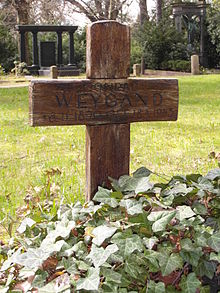Conrad Weygand
Conrad Oskar Emil Weygand (born November 8, 1890 in Leipzig , † April 18, 1945 there ) was a German chemist and university professor .
Life
The son of the Leipzig businessman Theodor Weygand attended the König-Albert-Gymnasium in his hometown from Easter 1901 to Easter 1910 and studied chemistry at the University of Leipzig from 1910 to 1914 . He then took part in the First World War and was taken prisoner by the French in September 1918 . After his release in February 1920, he returned to the University of Leipzig. In 1921 he received his doctorate. phil. in chemistry. Weygand was then assistant to Arthur Hantzsch until 1930 . His habilitation and appointment as a private lecturer in chemistry at the mathematical and natural science department of the Philosophical Faculty of the University of Leipzig took place in 1925. In 1930 he was appointed non-scheduled professor of chemistry and, from 1935, scheduled extraordinary professor.
In 1938 he developed a method for classifying chemical reactions. In 1940 he was elected a member of the Leopoldina . His book Organic-Chemical Experimental Art was regarded as a standard work, which received several editions and revisions. It was also translated into English and Russian after 1945.
Weygand was a member of the NSDAP and the German Chemical Society . He represented similar ideas as Philipp Lenard , the leading representative of German physics , and did not hide his anti-Semitic attitude. Weygand's German Chemistry as a Teaching of Material (1942) is regarded as the “programmatic writing” of German chemistry . After 1945, a university statement confirmed that Weygand was not an activist, but a follower of National Socialism .
As the commander of a Volkssturm unit , Conrad Weygand fell in the last fighting for Leipzig. He was buried in the Südfriedhof in Leipzig.
Works (selection)
University publications
- About isomeric salts from compounds similar to acetic acid esters (Part I); On the reaction of propiophenone with aromatic amines (Part II) , Phil. Dissertation, in: Yearbook of the Philosophical Faculty Leipzig (excerpts), Leipzig 1921. 2. pp. 216–218; Part II in: Reports of the German Chemical Society, vol. 47, 1943
- Contributions to the constitution problem of the keto-enols from 1,3-diketones (Part I); About the reaction of hydroxylamine with enol ethers and acetylene ketones and about a new, constitutively unambiguous synthesis of isoxazole (Part II) , habilitation thesis, Berlin 1927
Monographs
- Quantitative analytical micro-methods of organic chemistry in a comparative representation , Akademische Verlagsgesellschaft, Leipzig 1931
- Organic-chemical experimentation , Johann Ambrosius Barth, Leipzig 1938
- Chemical morphology of liquids and crystals , Akademische Verlagsgesellschaft, Leipzig 1941
- German chemistry as a study of matter , Max Niemeyer, Halle / Saale 1942
Translations
- Organic Preparations , Interscience Publishers, New York 1946 [English translation of the 2nd part of the organic-chemical experimental art]
- Metody ėksperimenta v organičeskoj chimii , 3 vols., Izd. inostrannoj literatury, Moscow 1951–52 [Russian translation of organic-chemical experimental art]
Essays
- About dimensionally stable, isolated, crystalline-liquid formations. 4. Contribution to the chemical morphology of liquids , in: Journal for physical chemistry, chemistry of elementary processes, structure of matter , vol. 53, Akademische Verlagsgesellschaft, Leipzig 1942
- About the regularity in homologous series and their practical significance , in: Nova Acta Leopoldina , Vol. 13, Ed. 91-98, Johann Ambrosius Barth, Leipzig 1944
Cooperation
- Handbook of Plant Analysis , 4 vol., Ed. von Gustav Klein, Vol. 1: General methods of plant analysis , Springer, Vienna 1931
literature
- Gerhard Lüdtke (Ed.): Kürschner's German Scholars Calendar 1931 , de Gruyter, Berlin and Leipzig, Sp. 3254
- Horst Remane : Conrad Weygand (1890-1945). A representative of German chemistry , in: Gerhard W. Pohl (Ed.): Proceedings for the lecture conference on natural sciences and politics. Focus: the years 1933–1955 , conference on April 12 and 13, 1996 of the Society of Austrian Chemists, Working Group on the History of Chemistry, University of Innsbruck, Institute for Analytical Chemistry and Radiochemistry, Innsbruck 1996, pp. 81–89
- Lothar Beyer , Rainer Behrends: De Arte Chemiae. Chemist and chemistry at the Alma mater Lipsiensis. Art treasures, book holdings and archive documents from the University of Leipzig and other collections , Passage Verlag, Leipzig 2003
- Willi Gorzny (arrangement): German Biographical Archive. New series up to the middle of the 20th century (DBA II) , Saur, Munich 2005
Web links
Individual evidence
- ^ King Albert Gymnasium (Royal Gymnasium until 1900) in Leipzig: Student album 1880–1904 / 05 , Friedrich Gröber, Leipzig 1905.
- ↑ a b De Artes Chemiae, p. 164.
- ^ Helmut Maier : Chemists in the "Third Reich". The German Chemical Society and the Association of German Chemists in the National Socialist Ruling Apparatus , Wiley, Weinheim 2015, ISBN 978-3-527-33846-7 , p. 324 f.
- ↑ The tomb was abandoned in 2014.
| personal data | |
|---|---|
| SURNAME | Weygand, Conrad |
| ALTERNATIVE NAMES | Weygand, Conrad Oskar Emil (full name) |
| BRIEF DESCRIPTION | German chemist and university professor |
| DATE OF BIRTH | November 8, 1890 |
| PLACE OF BIRTH | Leipzig |
| DATE OF DEATH | April 18, 1945 |
| Place of death | Leipzig |
